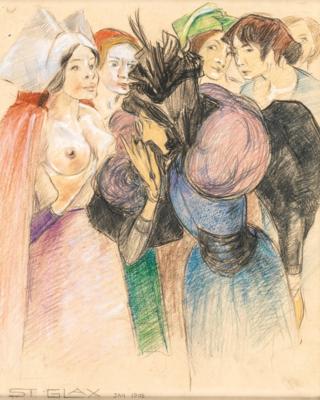Stephanie Glax

(Rohitsch-Sauerbrunn/Slovenia 1876-1952 Milan)
In a music hall in Paris, signed and dated St. Glax Jan 1905, pastel on paper, 28,5 x 23,5 cm, framed, an exhibition label on the reverse, (BH)
Stephanie Glax was one of the early Austrian female artists and, from an international perspective, was one of the first female poster designers. Moreover, she did not allow herself to be squeezed into the narrow image of women of her time’s social life. She spent her early years in Bad Rohitsch-Sauerbrunn in Styria (today Slovenia). In 1885 she moved to Opatija (Abbazia), at first only in the winter months and then the whole year, where her father, Dr. Julius Glax, a physician was the director of a spa. Stephanie Glax studied from 1896 to 1900 at the School for Applied Arts in Vienna under Franz Matsch und Felician von Myrbach and continued her studies in Munich and Paris.
In March 1899, on the occasion of the first „Faschings-Kränzchen“, which was organised by the „Vereins der Studentinnen der Universität Wien“ (Association of Female Students at the University of Vienna) in the Vienna amusement hall Ronacher a brief report on the artist appeared in the „Neue Freie Presse“: „Für die Tänzer hatte Fräulein Stephanie Glax, eine Schülerin der Kunstgewerbeschule des Oesterreichischen Museums, eine Tanzordnung gezeichnet, auf der man einen Bruder Studio mit dem Champagnerglase und eine Studentin mit dem Bierkruge in der Hand sah.“ (For the dancers, Miss Stephanie Glax, a female student of the School of Applied Arts of the Austrian Museum, had drawn a dance order, in which one saw a brother studio with a glass of champagne and a female student holding a half-liter glass of beer in her hand. (Neue Freie Presse, 5.3.1899, p. 7). This ironic reversal of gender roles was typical for the young female artist, who was not afraid to conquer terrains that until then had been occupied primarily by men. During her studies Glax was occupied intensively with consumer graphics. For the promotion of tourism in Abbazia she designed a series of graphics, posters and brochures, which provided the resort with a modern image. (Compare: Bernhard Denscher, Stephanie Glax, Austrian Posters, Beiträge zur Geschichte der Visuellen Kommunikation, www.austrianposters.at/2020/02/01/stephanie-glax)
Exhibited:
XIV. Esposizione Internazionale d'Arte - Venezia 1924.
Esperta: Mag. Barbara Hagerty
 Mag. Barbara Hagerty
Mag. Barbara Hagerty
+43-1-515 60-736
barbara.hagerty@dorotheum.at
04.04.2023 - 16:07
- Prezzo realizzato: **
-
EUR 5.500,-
- Stima:
-
EUR 2.000,- a EUR 3.000,-
- Prezzo di partenza:
-
EUR 1.500,-
Stephanie Glax
(Rohitsch-Sauerbrunn/Slovenia 1876-1952 Milan)
In a music hall in Paris, signed and dated St. Glax Jan 1905, pastel on paper, 28,5 x 23,5 cm, framed, an exhibition label on the reverse, (BH)
Stephanie Glax was one of the early Austrian female artists and, from an international perspective, was one of the first female poster designers. Moreover, she did not allow herself to be squeezed into the narrow image of women of her time’s social life. She spent her early years in Bad Rohitsch-Sauerbrunn in Styria (today Slovenia). In 1885 she moved to Opatija (Abbazia), at first only in the winter months and then the whole year, where her father, Dr. Julius Glax, a physician was the director of a spa. Stephanie Glax studied from 1896 to 1900 at the School for Applied Arts in Vienna under Franz Matsch und Felician von Myrbach and continued her studies in Munich and Paris.
In March 1899, on the occasion of the first „Faschings-Kränzchen“, which was organised by the „Vereins der Studentinnen der Universität Wien“ (Association of Female Students at the University of Vienna) in the Vienna amusement hall Ronacher a brief report on the artist appeared in the „Neue Freie Presse“: „Für die Tänzer hatte Fräulein Stephanie Glax, eine Schülerin der Kunstgewerbeschule des Oesterreichischen Museums, eine Tanzordnung gezeichnet, auf der man einen Bruder Studio mit dem Champagnerglase und eine Studentin mit dem Bierkruge in der Hand sah.“ (For the dancers, Miss Stephanie Glax, a female student of the School of Applied Arts of the Austrian Museum, had drawn a dance order, in which one saw a brother studio with a glass of champagne and a female student holding a half-liter glass of beer in her hand. (Neue Freie Presse, 5.3.1899, p. 7). This ironic reversal of gender roles was typical for the young female artist, who was not afraid to conquer terrains that until then had been occupied primarily by men. During her studies Glax was occupied intensively with consumer graphics. For the promotion of tourism in Abbazia she designed a series of graphics, posters and brochures, which provided the resort with a modern image. (Compare: Bernhard Denscher, Stephanie Glax, Austrian Posters, Beiträge zur Geschichte der Visuellen Kommunikation, www.austrianposters.at/2020/02/01/stephanie-glax)
Exhibited:
XIV. Esposizione Internazionale d'Arte - Venezia 1924.
Esperta: Mag. Barbara Hagerty
 Mag. Barbara Hagerty
Mag. Barbara Hagerty
+43-1-515 60-736
barbara.hagerty@dorotheum.at
|
Hotline dell'acquirente
lun-ven: 10.00 - 17.00
kundendienst@dorotheum.at +43 1 515 60 200 |
| Asta: | Acquerelli e miniature |
| Tipo d'asta: | Asta online |
| Data: | 04.04.2023 - 16:07 |
| Luogo dell'asta: | Wien | Palais Dorotheum |
| Esposizione: | 29.03. - 04.04.2023 |
** Prezzo di acquisto, esclusa la tassa e l'IVA dell'acquirente
Non è più possibile effettuare un ordine di acquisto su Internet. L'asta è in preparazione o è già stata eseguita.
